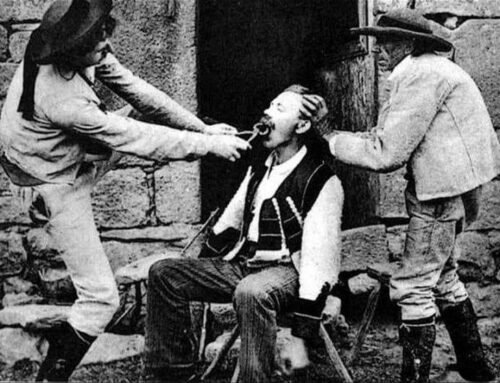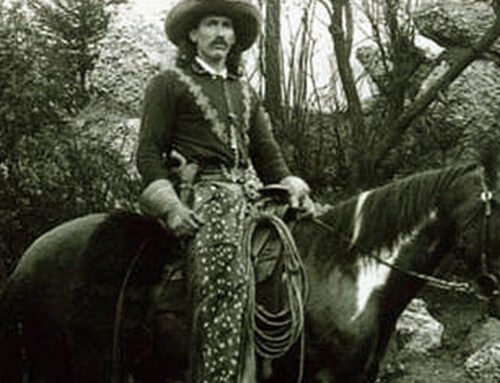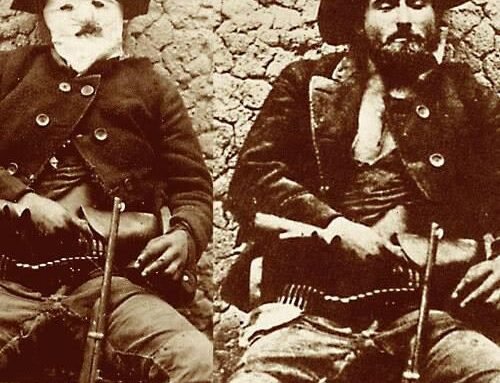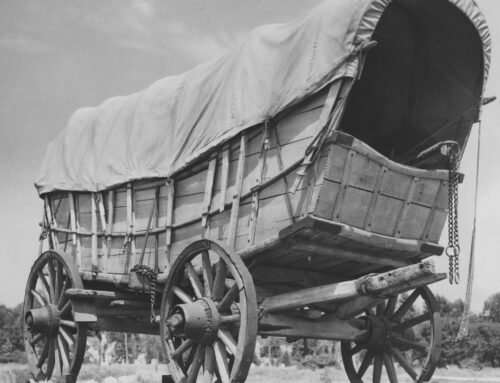Chuckwagons and feeding cowboys
By western author Nick Brumby
“A cowboy is a person who would rather throw a bull than eat beans with his knife.” – Charles Dorian
 Cowboys are tougher than rawhide, but after a long day in the saddle even the toughest cowpoke needs a good meal. Food was one of the few comforts a cowboy had when driving cattle north.
Cowboys are tougher than rawhide, but after a long day in the saddle even the toughest cowpoke needs a good meal. Food was one of the few comforts a cowboy had when driving cattle north.
Any good trail boss worth their salt knew this and ensured that the cowpunchers riding for his outfit ended every day with a full belly. For example, in 1892, 10 cowboys with the XIT ranch in Texas drove 2500 cattle from Channing to north of Miles City, Montana, where the Yellowstone River and Cedar Creek meet.
XIT trail boss Ealey Moore kept track of the supplies that cook Sam Williamson used along the way. For a start, each day the cook ground and brewed almost two pounds of coffee beans and cooked 10 pounds of bacon. During the 13 week drive, the outfit ate it way through 40 pounds of rice, 160 pounds of beans, 9 gallons of sorghum, almost 300 pounds of fruit (including dried currants and prunes as well as dried, fresh, and canned apples and peaches), 405 pounds of white sugar and 1750 pounds of white flour.

Providing this amount of food each day every day while out on the range would have been impossible without some sort of mobile field kitchen to help. In the early days of the great trail drives, each cowboy was responsible for his own meals and had to make do with what he could carry with him. However, this was not satisfactory. Thus, the chuckwagon was born.
A chuckwagon (also called a camp wagon or round-up wagon) is a horse-drawn wagon operating as a mobile field kitchen and frequently covered with a white tarp. Texas rancher Charles Goodnight is credited with inventing the first chuckwagon in 1866. Known as ‘the father of the Texas panhandle’, Goodnight’s riders often herded cattle in country not reachable by railroads, but still needing to be fed.
 Goodnight took a sturdy Civil War army-surplus Studebaker wagon, and added a “chuck box” to the back of the wagon, with drawers and shelves for storage space and a hinged lid to provide a flat working surface. His workers also attached a water barrel, while canvas was hung underneath to carry firewood. He also added a wagon box to store cooking supplies and whatever gear his cowboys brought with them.
Goodnight took a sturdy Civil War army-surplus Studebaker wagon, and added a “chuck box” to the back of the wagon, with drawers and shelves for storage space and a hinged lid to provide a flat working surface. His workers also attached a water barrel, while canvas was hung underneath to carry firewood. He also added a wagon box to store cooking supplies and whatever gear his cowboys brought with them.
Goodnight’s chuckwagon proved to be a great hit and became a fixture for any outfit moving cattle across country. Key to its success was its versatility. The chuck box stored cooking utensils, spices, and essential ingredients, such as dried beans and coffee. Underneath the chuck box was a pan boot to hold heavy pots and pans, such as a Dutch oven, which was used for baking each night. When fully loaded with fuel, food, cooking implements, a water barrel, and bedding, a chuckwagon setting off on a new trail drive could weigh several tons.
 However, the chuckwagon was nothing without a cattle drive cook. Next to the trail boos, ‘Cookie’ was the most important man in the outfit. He wielded considerable power in the and might earn four times the pay of the cowhands. His other duties included stakeholder on bets, arbiter on arguments, doctor and veterinarian, banker, barber and father-confessor. Woe be it for any cowhand who fell foul of the cook. In fact, the cook was so important he was honored with any number of nicknames other than ‘Cookie’, including Coosie, Soggy, Pot Rustler, Lean Skillet, Old Pud, Old lady, Belly Cheater, Biscuit Roller, Dough Boxer, Dough Puncher, Greasy Belly, Grub Worm, Gut Robber, and Sourdough.
However, the chuckwagon was nothing without a cattle drive cook. Next to the trail boos, ‘Cookie’ was the most important man in the outfit. He wielded considerable power in the and might earn four times the pay of the cowhands. His other duties included stakeholder on bets, arbiter on arguments, doctor and veterinarian, banker, barber and father-confessor. Woe be it for any cowhand who fell foul of the cook. In fact, the cook was so important he was honored with any number of nicknames other than ‘Cookie’, including Coosie, Soggy, Pot Rustler, Lean Skillet, Old Pud, Old lady, Belly Cheater, Biscuit Roller, Dough Boxer, Dough Puncher, Greasy Belly, Grub Worm, Gut Robber, and Sourdough.
One of his most important jobs was carried out in the early hours, before the cowhands climbed out of their bedrolls, Around 3am cookie would grind roasted coffee beans to make a pot of joe — usually strong enough to “float a horseshoe.” At the cook’s call, camp began to stir. Whether it was the clang of a metal triangle or the familiar “Come and get it”, cowboys would hurry along to get their share.
 Chuckwagon food typically included easy-to-preserve items such as beans, salted meats, coffee, and sourdough biscuits. Food would also be gathered along the way. There was no fresh fruit, vegetables, or eggs available, and meat was not fresh unless a longhorn was injured during the run and therefore had to be killed. Instead they uusually ate greasy cloth-wrapped bacon, salt pork, and beef, usually dried, salted or smoked.
Chuckwagon food typically included easy-to-preserve items such as beans, salted meats, coffee, and sourdough biscuits. Food would also be gathered along the way. There was no fresh fruit, vegetables, or eggs available, and meat was not fresh unless a longhorn was injured during the run and therefore had to be killed. Instead they uusually ate greasy cloth-wrapped bacon, salt pork, and beef, usually dried, salted or smoked.
Vegetables usually came in cans that were called “air tights.” Tomatoes were a favorite among the outfit. Canned tomatoes contained sugar to sweeten them and help reduce the acidity, as well as countering the gypsum-filled water that most rivers contained.
When Cookie was finished for the day and before hitting the sack, he would always move the tongue of his chuck wagon to facing north. When the trail boss started in the morning the tongue told him the direction he would be moving the herd the day.
 Every cowboy quickly learned the unwritten rules around the chuck wagon. These included never tying a horse to the chuck wagon or even close so that dust wouldn’t blow into the food. Approaching riders always stayed downwind from the chuck wagon if they knew what was good for them, while members of the outfit were not allowed to horse about for the same reason.
Every cowboy quickly learned the unwritten rules around the chuck wagon. These included never tying a horse to the chuck wagon or even close so that dust wouldn’t blow into the food. Approaching riders always stayed downwind from the chuck wagon if they knew what was good for them, while members of the outfit were not allowed to horse about for the same reason.
Other chuckwagon rules:
- No one eats until Cookie calls
- When Cookie calls, everyone comes a runnin’
 Hungry cowboys wait for no man. They fill their plates, fill their bellies, and then move on so stragglers can eat
Hungry cowboys wait for no man. They fill their plates, fill their bellies, and then move on so stragglers can eat- Cowboys eat first, talk later.
- It’s okay to eat with your fingers. The food is clean
- If you’re refilling the coffee cup and someone yells “Man at the pot” you’re obliged to serve refills.
- Don’t take the last serving unless you’re sure you’re the last man.
- Food left on the plate is an insult to the cook.
- If you find any decent firewood, bring it back to the wagon
- Strangers are always welcome.
You can find some tried and true cowboy recipes here (courtesy: Legends of America)

About Nick Brumby
I like a good story. And of all stories, I love westerns the most.
As a kid, I spent far too many afternoons re-watching Clint Eastwood spaghetti westerns, picking up ‘Shane’ for just one more read, or saddling up beside Ben Cartwright when ‘Bonanza’ was on TV each afternoon.
I’m a former journalist and I love horses, dogs, and the occasional bourbon whiskey. I live with my wife, daughter and our ever-slumbering hound in a 1800’s-era gold mining town – our house is right on top of the last working gold mine in the area. There may not be much gold left, but there’s history wherever you look.
I hope you enjoy my westerns as much as I enjoyed writing them!
Happy trails,
Nick


 Hungry cowboys wait for no man. They fill their plates, fill their bellies, and then move on so stragglers can eat
Hungry cowboys wait for no man. They fill their plates, fill their bellies, and then move on so stragglers can eat
























